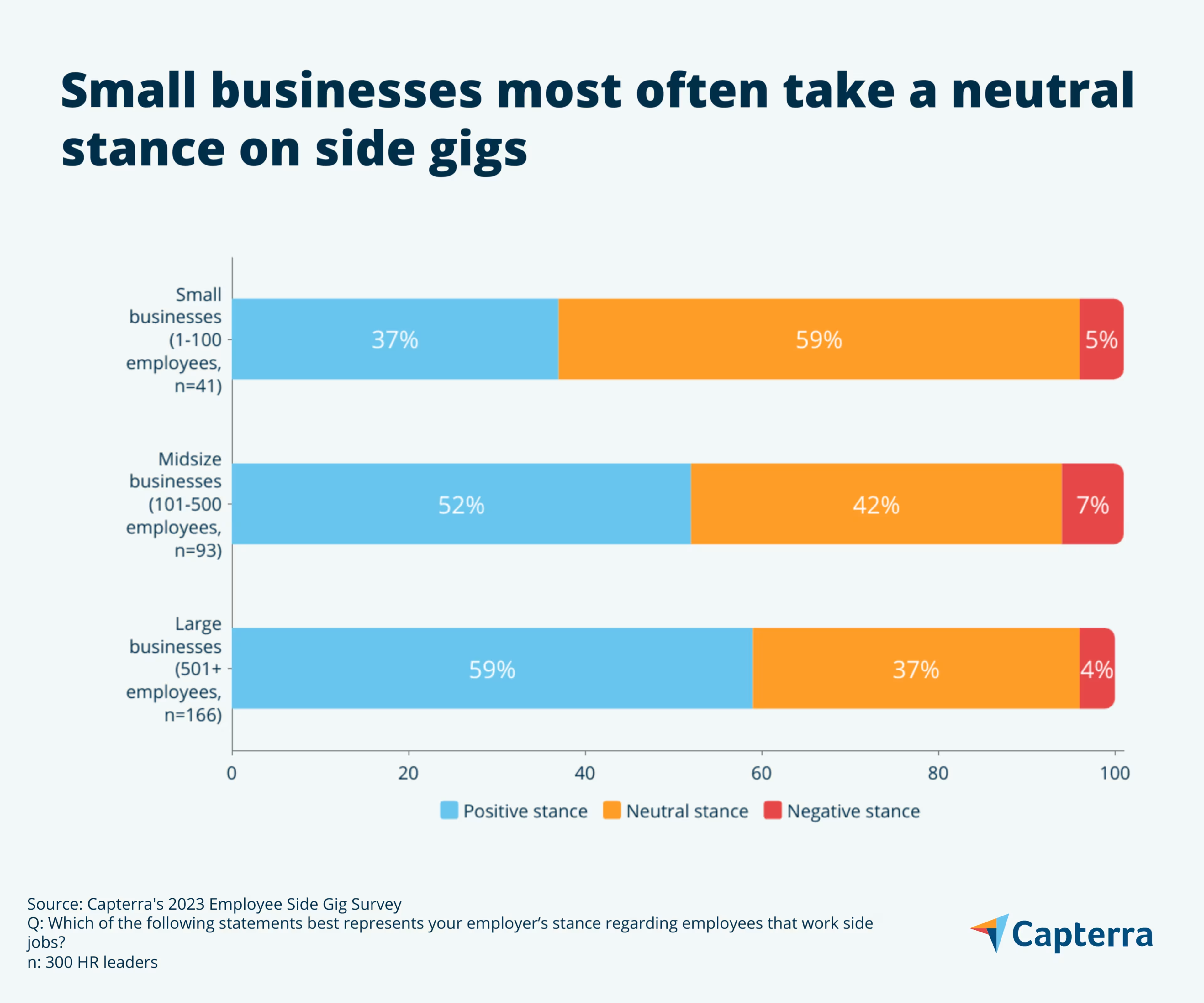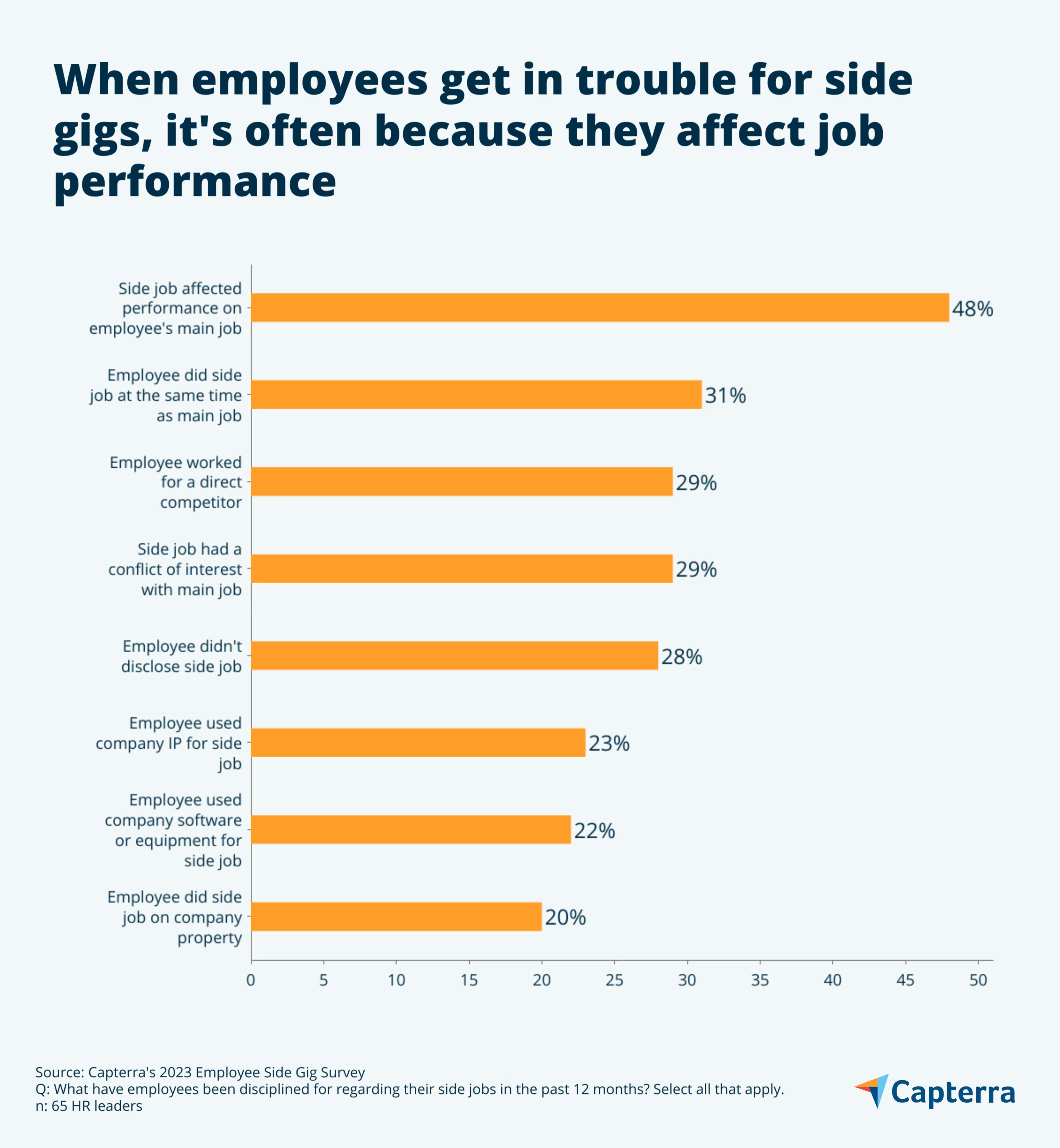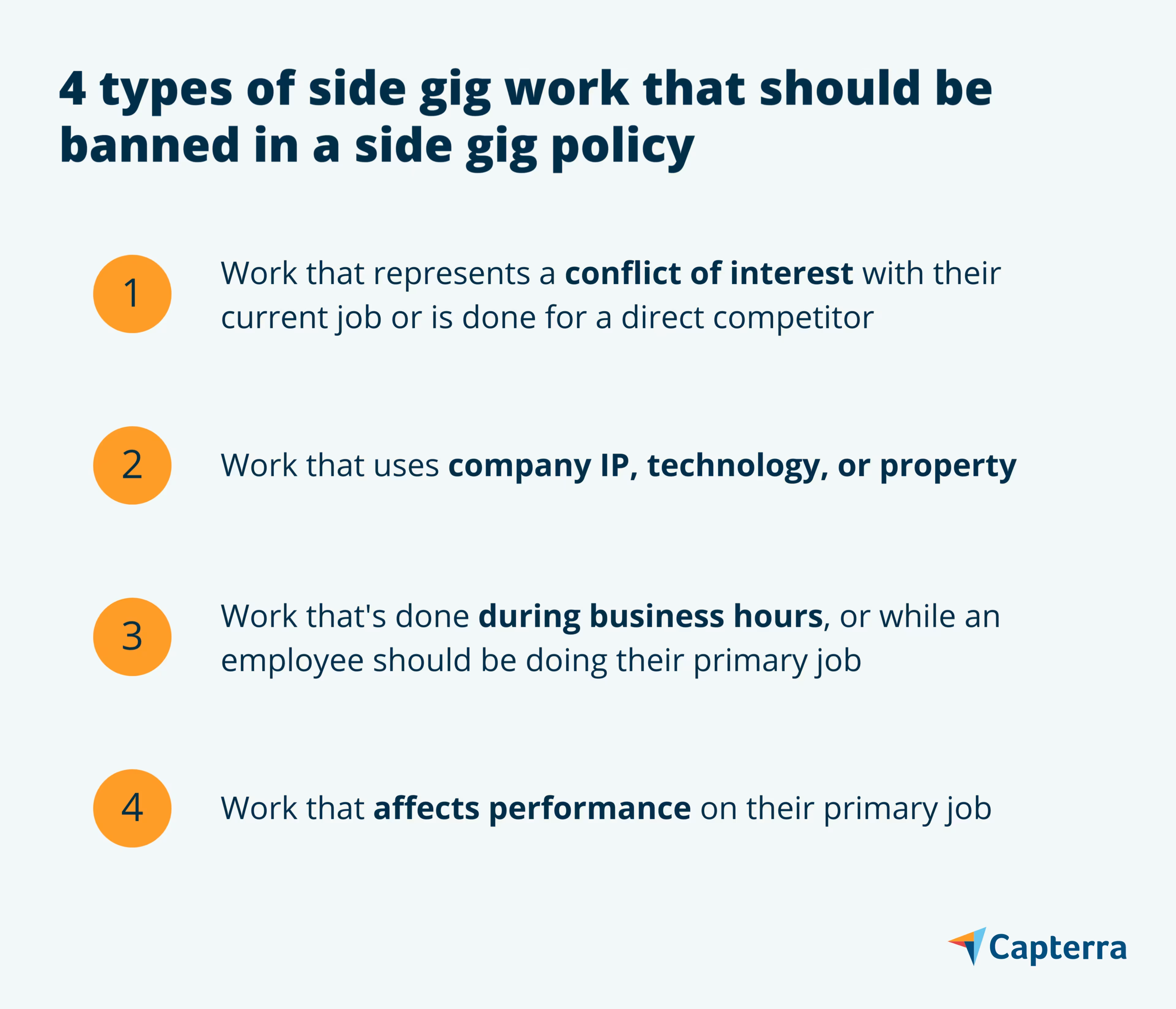Most businesses (54%) encourage side jobs, but conflicts demonstrate the need for guidelines
Facing cost-of-living increases and higher prices on consumer goods, more people are having to work multiple jobs to make ends meet. For younger workers especially, "side gigs" have become commonplace: A study earlier this year found that 46% of Gen Zs and 36% of millennials have a full- or part-time job on top of their primary one—most often to make more money.[1]
If you're in HR, this trend isn't necessarily a bad thing. In fact, according to our 2023 Employee Side Gig Survey*, a majority of businesses (54%) actually take a positive stance on side gigs—believing they allow workers to grow their skill sets and pursue outside passions.
This doesn't mean you should completely ignore this increase in side gig activity. As more employees take on secondary jobs, the possibility that they use your company's property, technology, or IP for another employer goes up. And with close to half of the HR leaders in our survey (45%) saying their employer doesn't have a formal side gig policy, it's clear a lot of HR departments haven't done their due diligence to protect company assets.
/ Key findings
1. Side gigs are on the rise: 48% of HR leaders say more of their employees are working side jobs now compared to last year, and only 18% say fewer employees are working side jobs.
2. Most employers think side gigs are a good thing (except small businesses): Overall, 54% of HR leaders say their employer takes a positive stance on side jobs. However, 59% at small businesses (1-100 employees) say their employer takes a neutral stance on side jobs.
3. Close to 1 in 5 employers (22%) have disciplined someone for a side gig in the past year: Most often, an employee was disciplined because their side gig was affecting performance on their primary job (48%).
More employees are working multiple jobs in 2023
Higher living expenses continue to eat away at take-home pay for U.S. workers. The Consumer Price Index (CPI)—a measure of the average change in prices for common goods like rent, food, and gasoline—rose 3.1% year-over-year in June 2023, while real average hourly earnings only rose 1.2% during the same span.[2]
With little relief in sight, and the looming possibility that student loan payments will resume in October, more people are taking on a secondary job this year to get by. Almost half of the HR leaders (48%) in our survey say more of their employees are working a side gig this year compared to last year. Only 18% believe that fewer employees have a side gig.

On average, the HR leaders in our survey believe that 39% of their workforce is working another job for a different employer. But some employers have noticed more side gig activity than others:
Bigger companies: HR leaders at large companies (over 500 employees) believe 40% of their workforce on average are working a side gig, compared to 35% for HR leaders at small companies (1-100 employees). Because larger companies more often operate in industries with a lot of lesser-paid, unskilled labor (like retail), this may explain why they're seeing slightly more side gig activity.
Hybrid workplaces: At hybrid workplaces, where most employees split their time between working from home and working at a company office, HR leaders believe 44% of their workforce is working a side gig, on average. At fully onsite workplaces, by contrast, this number drops to 33% (we did not have enough sample size to analyze this trend for fully remote companies). This phenomenon of employees doing multiple jobs while working from home was a contentious topic during the pandemic, and we're continuing to see those effects today.
Younger companies: HR leaders at companies that are less than five years old believe half (50%) of their workforce, on average, has a side gig. Those at companies that are 20 years or older, on the other hand, say only 30% have a side gig. We chalk this up to newer businesses being less able to offer competitive pay until they've found more solid financial footing.
Most employers view side gigs positively, with one exception: small businesses
With side gigs becoming increasingly common, there are three stances an employer can take:
The positive stance is that side gigs are actually a good thing because they allow employees to gain new skills and pursue outside passions without adding cost. The end result is a happier and more productive workforce.
The neutral stance is that side gigs don’t matter. Whatever employees do on their own time is not the employer’s business.
The negative stance is that side gigs are a bad thing because they increase distractions and burnout, leading to poorer performance on the employee's primary job.
Overall, a majority (54%) of HR leaders say their employer takes a positive stance on side gigs, slightly less (42%) take a neutral stance, and only 5% take a negative stance.
Yet if we break up our results by business size, we find that small businesses trend more neutral than positive. In regards to side gigs, a majority (59%) of the HR leaders from businesses with 1-100 employees say that whatever employees do outside of their organization is not their concern.

With less of a need for specialized skills (a smaller headcount necessitates a more generalized workforce skillset), small businesses simply don't reap as many benefits from workers gaining new skills from secondary jobs. This explains their more hands-off approach. The larger a business becomes, and the more specialized its employees’ skill sets need to be, the more it takes a positive stance.
Even with smaller businesses being more neutral, our data shows that a significant majority of businesses do not want to actively discourage side gigs. This is reflected by their official policies (or lack thereof): Only 4% of HR leaders in our survey say their employer has a rule that bans employees from having any type of side job.
Infractions show the need for side gig guidelines
With most businesses taking a positive or neutral stance on their employees working a side gig, it would make sense if HR departments chose not to address the matter at all—even as more of their workforce takes on another job. But our data shows that incidents when two jobs come into conflict do happen, necessitating the need to set expectations for how employees should go about their side gigs.
More than one in five HR leaders (22%) in our survey say they had to discipline an employee for working a side job in the past year. For HR leaders at hybrid workplaces, the number jumps to more than one in four (27%).
Most often, employees were disciplined because their side gig was affecting performance at their main job. But there were more serious incidents too, where employees were doing side gig work while they were supposed to be doing their main job, or even working for a direct competitor.

In almost half of cases where employees were disciplined, employees were let off with a warning (45%). But some employers haven’t been afraid to bring down harsher punishments for side gig infractions, such as putting an employee on a performance plan (37%), asking them to quit their side gig (31%), or even firing them (26%).
Half of businesses don't have a side gig policy—here’s how to create a good one
With side gigs offering perceived benefits to employers in the form of more highly-skilled, happier employees, it's not surprising to find that many employers haven't established any sort of guidelines or restrictions around them. In our survey, 45% of HR leaders say their employer doesn't have any kind of side gig policy. Among small businesses, that number is 63%.
That being said, we've shown that side gigs can affect employee performance or lead them to abuse company assets. And with more employees taking on extra jobs over time, having a side gig policy in place—even a minimal one—is a good idea. It can give clear instructions to employees about what is and isn't allowed in order to protect your business.
If you've never crafted a side gig policy before, here are some best practices:
If you want to ban all side gigs, you can
Even though most employers are in favor of side gigs, yours may not be one of them. You could have highly sensitive company secrets, or may simply want employees to be fully focused when they come to work. If that's the case, employment attorney Austin Kaplan says the law is on your side if you want to forbid employees from taking on a side gig.[3]
"Employers commonly require executives and other employees, subject to the terms of employment agreements, to devote full working efforts solely to the employer. This is to guarantee best efforts and avoid conflicts of interest, and it is enforceable."


Austin Kaplan
employment attorney
You can implement this ban as part of an employment agreement, or in the form of a "no moonlighting" policy. Be prepared for possible consequences, though. If employees need a side gig to make more money and your policy is too restrictive, they could be motivated to find a main job somewhere else.
Should employees be required to disclose their side gigs? Probably not
In our survey, 57% of HR leaders say employees at their company are required to report if they are working a side job for a different employer. It isn't the employers who want to disincentivize side gigs that are doing this most often, either: Among those that take a positive stance on side gigs, 71% of HR leaders say employees are required to report if they have one.
In theory, this is a great idea to stay on top of employees who may bend the rules for their second job. In practice, a reporting requirement can create undue stress, and give the wrong impression to employees that they're in trouble for working a side job. Employees may decide to hide their side gig work as a result: Among those with a side gig reporting requirement in our survey, respondents estimate only 60% of their workers with a side gig are actually complying with it.
With such a low compliance rate, it’s best to not have a reporting requirement in place, and instead address issues resulting from a potential side gig as they happen.
Keep it simple
Ultimately, Kaplan says the best side gig policies don't get hamstrung on minute details.
"The best policies are always the simplest ones—short, clear, and easy to understand for employees; and easy to enforce for employers," Kaplan says.
Your side gig policy should make clear that four types of side gig work are not allowed:

Add your policy to your employee handbook and the company intranet, along with an explanation of the discipline that can happen for an infraction of the policy, and call it a day.
The right software can promote mutually beneficial side work (or put a stop to side gig conflicts)
As side gigs rise in the U.S., the key word from an employer's point of view is balance. Employees should feel encouraged to take on side work to pay their bills, pursue passions, or even learn important skills they can bring back to their primary job. At the same time, having multiple jobs can present opportunities for abuse that ultimately do your company more harm than good. A balance of compassion and consequence is necessary.
The right side gig policy can help companies strike this important balance, but so can the right technology. Here are some examples of HR software systems that can encourage the right kind of side work, while discouraging the wrong kind:
You can leverage career management software to help employees develop their careers through individual development plans and goals. Together, you can figure out what skills would be most beneficial for an employee to make their desired transition, and point them towards an internal position or a side gig that can help them develop that skill.
If you don't have the budget to raise an employee's salary to reduce their monetary need for a side gig, a financial wellness app can at least help them better manage their paycheck and give them guidance on how to build up savings and have more solid financial footing.
Using employee monitoring software, you can get an instant notification if an employee is on a website they shouldn't be on, using company tech during weird hours, or doing work that has nothing to do with their role. Recordings can be saved as evidence to justify subsequent consequences.
Track which employees are spending time on non-productive websites or applications in WebWork Time Tracker
If you liked this report, check out some of our other research on the latest HR trends:
Note: The applications shown in this article are an example to show a feature in context and are not intended as endorsements or recommendations. They were obtained from sources believed to be reliable at the time of publication.
